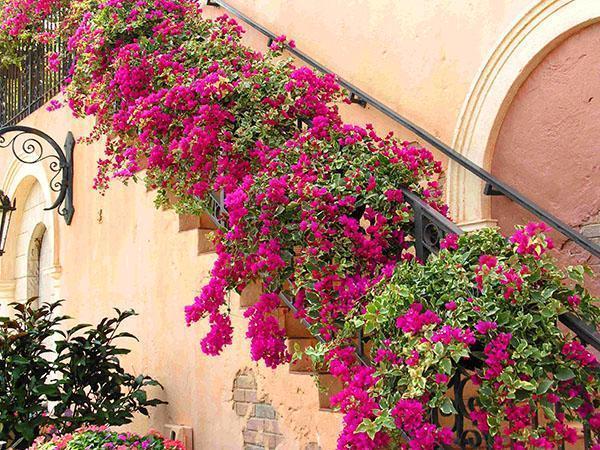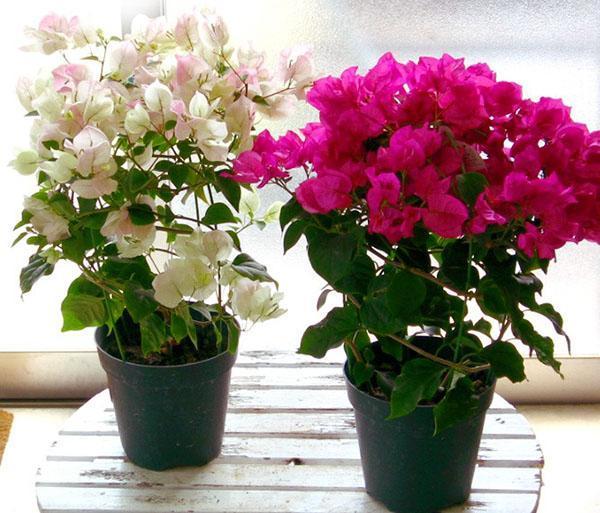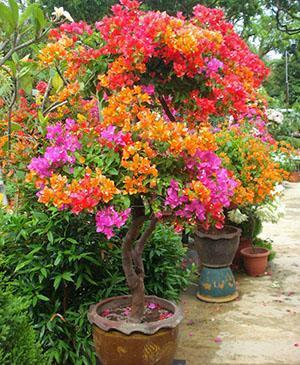Problems of growing bougainvillea at home
 In nature, spectacular bougainvilleas are large plants that feel at ease in the warm climate of South America. Success in growing this crop at home depends on knowing the characteristics of the plant and its preferences.
In nature, spectacular bougainvilleas are large plants that feel at ease in the warm climate of South America. Success in growing this crop at home depends on knowing the characteristics of the plant and its preferences.
The main interest in bougainvillea is due to its flowering. But not everyone knows that white, purple, yellow and pink clusters at the ends of the shoots are not flowers, but modified leaves or bracts surrounding the very modest, almost imperceptible true flowers of the plant. Near each yellowish-white corolla there are three heart-shaped bracts up to 6 cm long.
If a florist notices that his pet bougainvillea at home is losing leaves, or bright bracts are falling off the plant, most often the cause of the problem is a change in the conditions of detention.
A change in state can be provoked by:
- transferring a plant from the open air, where it was located in the warm season, to an apartment;
- moving a flower from a store to a house;
- seasonal changes in temperature and humidity conditions in the apartment.

But in some cases, the problem does not resolve itself, and bougainvillea requires increased attention from the grower.
Why does bougainvillea shed foliage?
 In addition to changing location, drafts become a reason for the deterioration of the well-being of room culture. Bougainvillea reacts sharply to the movement of cold air jets. This applies to:
In addition to changing location, drafts become a reason for the deterioration of the well-being of room culture. Bougainvillea reacts sharply to the movement of cold air jets. This applies to:
- the wind blowing a flower in the garden, on the balcony or on the loggia in the summer;
- situations when bougainvillea at home is at an open window or under a transom.
The transfer of the pot to another window, as well as the rotation of the container with the plant preparing for flowering, can also push the foliage to drop.
Violation of the watering regime is no less dangerous for bougainvillea.
It is important to remember that warm weather and an active growing season require maintaining constant soil moisture. It is equally dangerous to dry out the root system and its flood, when moisture stagnates in the pan and soil inside the pot.
Since bougainvilleas at this time need less moisture, then watering in winter is needed more sparse and less. If the plant is regularly poured, answer the question: “How muchat is the boughervillea shedding foliage? " very simple. The root system does not have time to absorb the incoming moisture, metabolic processes are disrupted. The result is yellowing and withering foliage on a newly green plant.
Similar processes are carried out if the culture does not receive water. With limited nutrition, the leaves from the bougainvillea fall green. The same fate awaits the bracts covering the ends of the branches.
Like cold drafts, dry hot air coming from heating devices... The dryness of the air has an extremely negative effect on the tender shoots formed in early spring. Even on the remaining living branches, deformed defective bracts and leaves are formed.
 Like other indoor crops, bougainvillea is attacked by sucking insect pests that weaken the plant.Of particular danger are spider mites, which attack a flower in room conditions at low air humidity. When gardening, scabbards, aphids, caterpillars and whiteflies that eat greens are dangerous for the plant.
Like other indoor crops, bougainvillea is attacked by sucking insect pests that weaken the plant.Of particular danger are spider mites, which attack a flower in room conditions at low air humidity. When gardening, scabbards, aphids, caterpillars and whiteflies that eat greens are dangerous for the plant.
EIf the plant is taken out to the loggia or garden in the summer, you need to carefully monitor the fluctuations in night temperatures. In August and September, when the air cools down to + 5 ° C, bougainvillea can freeze and lose not only foliage, but also part of young shoots.
Why does bougainvillea not bloom at home?
 A green bougainvillea specimen can also cause anxiety in the grower due to the lack of flowering or its scarcity. Keeping a plant in a small pot pushes it to the appearance of buds, and a bulky container for growth makes a healthy flower “fatten” and refuse to bloom.
A green bougainvillea specimen can also cause anxiety in the grower due to the lack of flowering or its scarcity. Keeping a plant in a small pot pushes it to the appearance of buds, and a bulky container for growth makes a healthy flower “fatten” and refuse to bloom.
The reason why bougainvillea does not bloom in indoor conditions may be an improperly organized rest period or its complete absence. Being in a room where it is warmer than 10–12 ° C, bougainvillea is reluctant to lay the rudiments of buds, so you should not expect a beautiful flowering next season.
Cool, rainy weather during the summer has a similar effect on flowering quality. Moreover, even the formed bracts have a faded color than usual.
In addition to the fading of the bracts, a lack of light causes the shoots to stretch out, the plant loses its shape, which is carefully maintained by pruning. This circumstance becomes especially unpleasant for owners of bonsai grown on the basis of bougainvillea.
 Sometimes the reason why bougainvillea does not bloom at home remains unknown. But you can activate the formation of buds if you arrange a small "diet" for the flower. Depending on the state of the plant and its size, feeding is stopped for 2-4 weeks and is limited watering... A portion of water is given to the plant only after the top layer of the soil has dried. The signal that bougainvillea is ready to bloom is the formation of young shoots with flower buds at the ends. After that, top dressing and watering are resumed as before.
Sometimes the reason why bougainvillea does not bloom at home remains unknown. But you can activate the formation of buds if you arrange a small "diet" for the flower. Depending on the state of the plant and its size, feeding is stopped for 2-4 weeks and is limited watering... A portion of water is given to the plant only after the top layer of the soil has dried. The signal that bougainvillea is ready to bloom is the formation of young shoots with flower buds at the ends. After that, top dressing and watering are resumed as before.
Pruning bougainvillea at home
In the spring, indoor bougainvillea is subjected to shaping pruning, during which all weakened or dried shoots are removed, and full-fledged annual branches are cut half the length.
 In the summer, to maintain decorativeness and simplify care, bougainvillea shortens the faded shoots, leaving 4–6 buds on them. This measure helps to activate the growth of young shoots, on which new flowers may open already this season.
In the summer, to maintain decorativeness and simplify care, bougainvillea shortens the faded shoots, leaving 4–6 buds on them. This measure helps to activate the growth of young shoots, on which new flowers may open already this season.
Lignified shoots older than 3-4 years should not be cut off, since the buds on adult branches either do not wake up at all, or they do it very reluctantly.
Due to the ease with which bougainvillea tolerates pruning at home, on the basis of this culture, with the help of shaping measures, not only compact bushes are grown, but also graceful standard trees, as well as spectacular bonsai. No less interesting are the compositions where bougainvilleas are entwined with curly frames, decorative trellises or trellises.